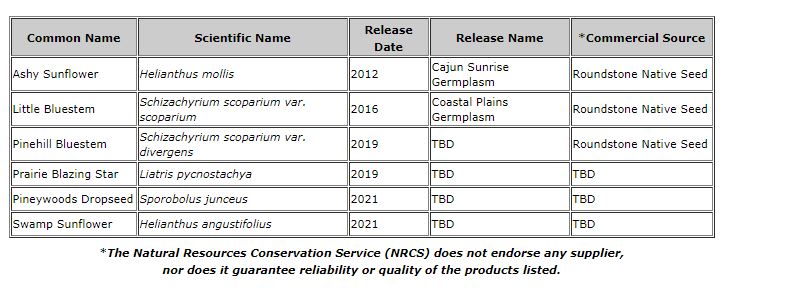Filling the Void of Adapted Plant Releases for the Southeastern United States
go.ncsu.edu/readext?577400
en Español / em Português
El inglés es el idioma de control de esta página. En la medida en que haya algún conflicto entre la traducción al inglés y la traducción, el inglés prevalece.
Al hacer clic en el enlace de traducción se activa un servicio de traducción gratuito para convertir la página al español. Al igual que con cualquier traducción por Internet, la conversión no es sensible al contexto y puede que no traduzca el texto en su significado original. NC State Extension no garantiza la exactitud del texto traducido. Por favor, tenga en cuenta que algunas aplicaciones y/o servicios pueden no funcionar como se espera cuando se traducen.
Português
Inglês é o idioma de controle desta página. Na medida que haja algum conflito entre o texto original em Inglês e a tradução, o Inglês prevalece.
Ao clicar no link de tradução, um serviço gratuito de tradução será ativado para converter a página para o Português. Como em qualquer tradução pela internet, a conversão não é sensivel ao contexto e pode não ocorrer a tradução para o significado orginal. O serviço de Extensão da Carolina do Norte (NC State Extension) não garante a exatidão do texto traduzido. Por favor, observe que algumas funções ou serviços podem não funcionar como esperado após a tradução.
English
English is the controlling language of this page. To the extent there is any conflict between the English text and the translation, English controls.
Clicking on the translation link activates a free translation service to convert the page to Spanish. As with any Internet translation, the conversion is not context-sensitive and may not translate the text to its original meaning. NC State Extension does not guarantee the accuracy of the translated text. Please note that some applications and/or services may not function as expected when translated.
Collapse ▲USDA NRCS | 1/25/2019
Successful conservation plantings depend on many variables, most of which are beyond human control. One critically important factor within human control is the use of well-adapted and performance tested native seed sources. The use of regionally adapted native seed increases the chances of long-term success and survival of conservation plantings while reducing the costs associated with reseeding failed attempts or conducting multiple plantings over time to compensate for reduced performance of low quality or non-adapted material.
The commercial native seed market has a void of regionally adapted species for the southeastern United States. Most commercially available native seed sources originate from plant materials collected in the prairie regions of the central and western United States. Use of this material in the southeast has resulted in stand failures or weak stands of native vegetation that do not persist over time. The NRCS in Louisiana specifically noticed this trend in restoration efforts of coastal prairies and requested the development of regionally adapted species for use in restoration efforts in the region. The Plant Materials Program, through its network of plant materials centers and partnering agencies, has moved forward to address this need.
The East Texas Plant Materials Center (ETPMC) has partnered with the Texas Native Seeds program, the United States Forest Service, and the Stephen F. Austin Pineywoods Native Plant Center to develop a core mix of important native plant species for use in conservation plantings throughout the southeastern United States. Plant collections from across the region are being evaluated at the ETPMC for performance and seed production. Selected material from these evaluations will be tested for adaptation across Land Resource Region P at plant materials centers in Arkansas, Mississippi, Georgia, and Florida. Land Resource Region P dominates the southeastern United States and comprises two critically important declining habitats: longleaf and shortleaf pine eco-systems. The longleaf and shortleaf pine eco-systems are both fire evolved habitats comprised of forested grasslands that provide critical habitat for wildlife, store carbon to combat climate change, and provide healthy soils that improve water quality and prevent soil loss. Providing adapted and tested native understory seed for conservation plantings is critical to restore these declining habitats and improve ecosystem function.

A list of species that have been released or are in evaluation is provided below with their current status and projected completion dates.


